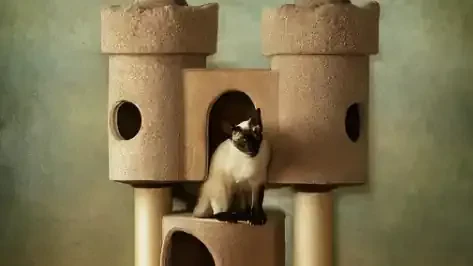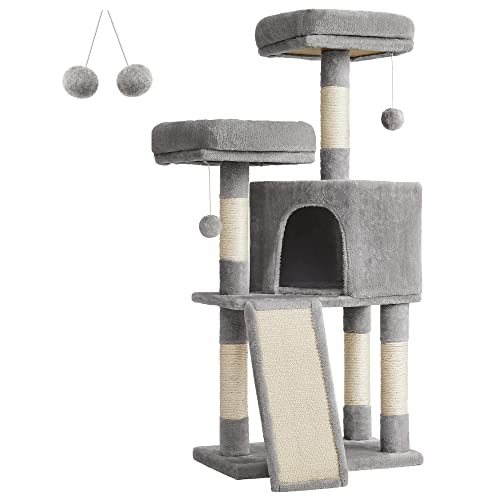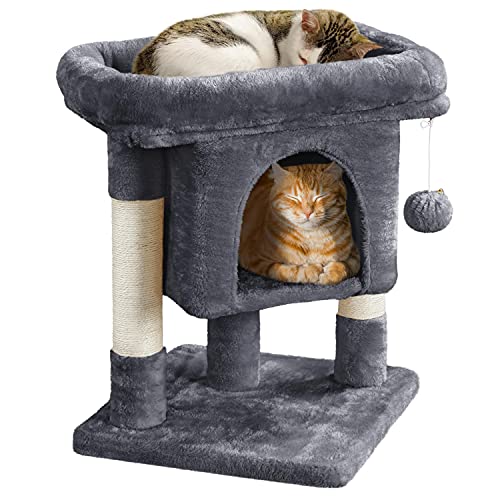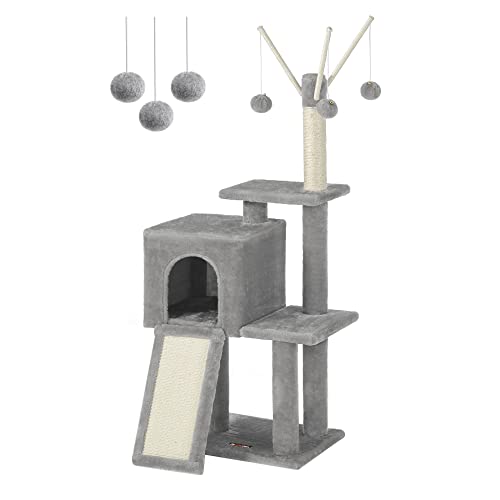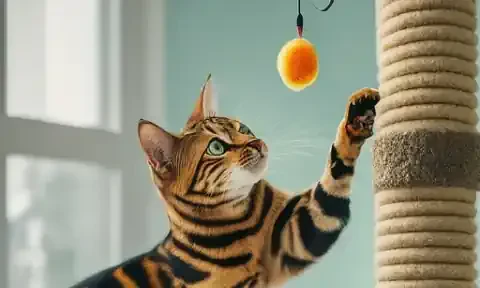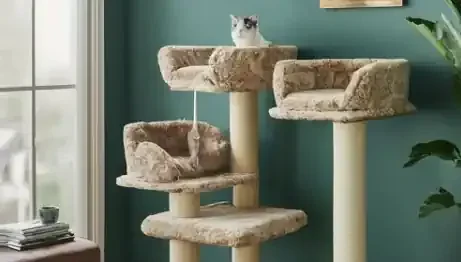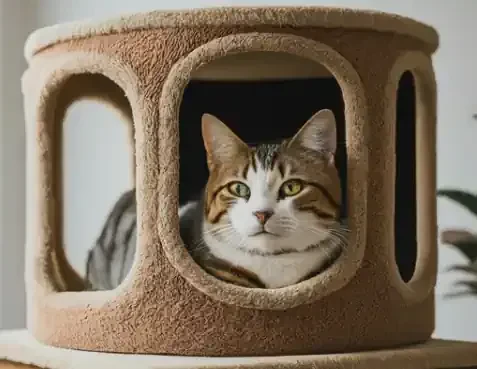Understanding the Importance of Cat Trees: Beyond Playtime
Cat trees are often viewed as mere scratching posts or platforms for feline frolicking. Yet, their significance reaches far beyond simple amusement. Delving into a cat's instinctive needs and the profound benefits of a well-chosen cat tree reveals why these structures are essential for a fulfilling feline life.
Why Climbing is a Feline Instinct
In the wild, cats are natural climbers. Scaling trees offers vantage points for hunting, a refuge from predators, and a place to survey their territory. This instinctual drive doesn't disappear in domesticated cats. A cat tree serves as a substitute for those towering oaks, allowing them to indulge in their innate urge to ascend and perch high above the ground.
The Mental and Physical Benefits of Scratching
Scratching isn't just about sharpening claws; it's a complex behavior with both physical and mental advantages. Physically, scratching helps remove dead nail sheaths and stretches the muscles in a cat's back, legs, and paws. Mentally, it serves as a stress reliever and a way for cats to mark their territory with scent glands in their paws. A cat tree with multiple scratching surfaces caters to this essential feline need.
How a Cat Tree Becomes a Safe Haven
Cats are territorial creatures who crave security. A cat tree, especially one with enclosed condos or perches, can become their personal sanctuary. It offers a retreat from the hustle and bustle of the household, a place where they can relax, observe their surroundings, and recharge. This sense of safety contributes to a cat's overall well-being and happiness.
Real-Life Stories: Cat Tree Transformations
The impact of a cat tree isn't merely theoretical. Countless cat owners have witnessed remarkable transformations in their feline companions after introducing a suitable climbing structure. Shy cats have emerged from their shells, anxious cats have found solace, and energetic cats have channeled their excess energy into healthy play. These real-life stories underscore the power of cat trees to enrich a feline's life.
Kitten Climbers: Setting the Stage for a Healthy Cat Life
The formative months of a kitten's life are a whirlwind of exploration and boundless energy. A well-chosen cat tree becomes their playground, gym, and classroom all in one. Selecting the right tree at this stage not only fosters a healthy and active lifestyle but also sets the foundation for a lifelong love of climbing and scratching.
Must-Have Features for Playful Kittens
Kittens are naturally curious and adventurous, demanding a cat tree that caters to their playful instincts. Look for features like:
Dangling Toys: These spark a kitten's hunting instincts and provide hours of entertainment. Ensure toys are securely attached to prevent choking hazards.
Multiple Levels: Different heights encourage climbing and jumping, developing coordination and muscle strength.
Scratching Posts: Kittens are learning to scratch, and a variety of textures (sisal, carpet, wood) cater to their preferences.
Enclosed Spaces: A cozy condo or cubbyhole provides a safe haven for naps and quiet time.
Stability and Safety First: Preventing Tipping Tragedies
Kittens are notorious for their rambunctious play, which can lead to toppling cat trees. Opt for a sturdy base and a tree that's wider at the bottom than the top. If necessary, anchor the tree to the wall for extra security. Choose materials that won't easily tip, and avoid top-heavy designs.
Soft Materials for Gentle Paws
A kitten's paws are delicate, so choose a cat tree with soft, plush materials for their comfort. Avoid rough fabrics or materials that could snag their tiny claws. Cozy fleece, faux fur, and plush carpeting are ideal choices for their sensitive pads.
Budget-Friendly Options for Growing Kittens
Kittens grow rapidly, so it's tempting to invest in a large, elaborate cat tree. However, they may quickly outgrow it. Consider budget-friendly options that offer the essential features a kitten needs without breaking the bank. As your kitten matures, you can upgrade to a more substantial tree.
When to Upgrade from a Kitten Tree
There's no hard and fast rule for when to upgrade a kitten's tree. However, if your kitten frequently reaches the top without effort, struggles to fit comfortably in the enclosed spaces, or starts showing disinterest in the tree's features, it might be time to consider a larger, more challenging option. This typically happens around 6-9 months of age, but every kitten is different.
The Agile Adult: Cat Trees for Energetic Explorers
Adult cats, brimming with energy and curiosity, demand a cat tree that can keep pace with their adventurous spirit. From daring leaps to vigorous scratching sessions, their tree should be a multi-functional haven that satisfies their physical and mental needs.
Tall Towers and Multiple Levels
Adult cats thrive on vertical space. It allows them to indulge in their natural climbing instincts, offering various vantage points to survey their domain and bask in the sun. Tall towers and multiple platforms with varying heights provide the perfect playground for their acrobatic endeavors.
Durable Scratching Posts to Deter Furniture Destruction
Scratching is a vital behavior for adult cats, but it can wreak havoc on your furniture if not properly channeled. Invest in a cat tree with multiple scratching posts made from durable materials like sisal rope, wood, or woven fabric. These posts should be tall enough for a full-body stretch and securely attached to the tree's base to withstand enthusiastic scratching sessions.
Interactive Toys for Engagement
Adult cats need mental stimulation to prevent boredom and behavioral issues. Look for a cat tree with built-in interactive toys like hanging mice, feather wands, or puzzle feeders. These toys encourage play and exercise, keeping your feline friend engaged and entertained for hours.
Condo Hideaways for "Me Time"
Even the most sociable cats appreciate a private retreat. A cat tree with enclosed condos or partially enclosed cubbyholes provides a cozy space for your cat to nap, hide, or simply observe their surroundings undisturbed. This sanctuary is essential for their emotional well-being and allows them to recharge their batteries.
Open Perches for Surveying Their Kingdom
Adult cats are natural observers, and they love nothing more than a comfortable perch from which to survey their territory. A cat tree with open platforms at different heights caters to this desire, allowing them to bask in the sun, watch birds outside the window, or simply keep a watchful eye on their human companions.
Senior Sanctuary: Catering to the Mature Cat's Needs
As cats age, their needs and preferences evolve. The rambunctious kitten who once scaled dizzying heights might now prefer a more leisurely climb and a cozy spot for a long nap. Choosing a cat tree that caters to these changing needs is crucial for ensuring your senior cat's comfort, safety, and continued enjoyment.
Easy Access: Ramps, Stairs, and Low Platforms
Senior cats may experience joint stiffness or arthritis, making jumping and climbing more challenging. A cat tree with gradual ramps, wide stairs, and low platforms allows them to navigate with ease. These features eliminate the need for strenuous leaps and reduce the risk of falls or injuries.
Heated Beds for Comfort and Joint Relief
A heated bed can be a luxurious addition to a senior cat's tree. Gentle warmth soothes aching joints, promotes relaxation, and enhances overall comfort. Look for beds with adjustable temperature settings and safety features like automatic shut-off to prevent overheating.
Soft Surfaces for Sensitive Paws
Older cats often develop paw pad sensitivity. Choose a cat tree with plush, cushioned surfaces throughout, including perches, beds, and platforms. This extra padding reduces pressure on their paws and provides a comfortable resting spot for weary limbs.
Simple Designs for Graceful Aging
Senior cats may not be as agile as they once were, and complex cat tree designs can become overwhelming. Opt for a simple, intuitive layout with clear paths and ample space to move around. Avoid crowded structures with too many obstacles or challenging jumps.
Combining Cat Trees with Other Senior Cat Essentials
Consider integrating your senior cat's tree with other essential items like a litter box with low sides for easy entry, food and water bowls placed at a comfortable height, and soft bedding for extra comfort. This creates a comprehensive senior-friendly environment that caters to their every need.
Multi-Cat Households: The Art of Cat Tree Diplomacy
Maintaining harmony in a multi-cat household can be a delicate dance, and the cat tree plays a pivotal role in this feline ballet. A well-chosen tree can be a source of shared enjoyment, promoting social interaction and minimizing territorial disputes. However, choosing the wrong tree can exacerbate tensions and lead to conflict.
Size Matters: Plenty of Space for Everyone
In a multi-cat household, a cramped cat tree is a recipe for disaster. Each cat needs ample space to stretch, scratch, climb, and relax without feeling crowded or encroached upon. Opt for a large tree with multiple levels, platforms, and perches to ensure everyone has a comfortable spot to call their own.
Varied Heights and Activities to Avoid Conflict
Cats are hierarchical creatures, and they often establish a pecking order within the household. A cat tree with varying heights allows for a natural hierarchy, with dominant cats claiming the higher perches and more submissive cats opting for lower levels. Additionally, a variety of activities, such as scratching posts, dangling toys, and enclosed spaces, cater to different preferences, reducing competition for resources.
Separate Scratching Posts to Prevent Territorial Disputes
Scratching is not only a physical need but also a way for cats to mark their territory. In a multi-cat household, providing multiple scratching posts throughout the tree—and even in other areas of your home—can help prevent territorial disputes and reduce the likelihood of destructive scratching on furniture.
Multiple Escape Routes for Peace of Mind
Cats value escape routes, especially when feeling threatened or overwhelmed. A cat tree with multiple entry and exit points allows cats to avoid confrontation and retreat to a safe space when needed. Look for trees with platforms that are open on multiple sides, bridges connecting different levels, and tunnels or hammocks that offer hidden retreats.
Tips for Introducing a New Cat Tree to the Clowder
Introducing a new cat tree to a multi-cat household requires a thoughtful approach. Start by placing the tree in a neutral area of your home where all cats feel comfortable. Allow them to explore it at their own pace, and avoid forcing interaction. You can also try sprinkling the tree with catnip or placing treats on different levels to encourage positive associations.
Special Needs: Adapting the Cat Tree for Unique Cats
Not all cats are created equal, and their individual needs and preferences should be reflected in their chosen cat tree. Whether your feline friend is a giant Maine Coon, a shy Persian, or a senior with mobility issues, tailoring their tree to their unique requirements ensures their comfort, safety, and enjoyment.
Large Breed Considerations: Maine Coons, Bengals, and More
Large breed cats, such as Maine Coons, Norwegian Forest Cats, and Bengals, require cat trees that can withstand their size and weight. Look for sturdy, well-built trees with reinforced platforms and extra-wide bases for stability. Taller structures with ample space between levels accommodate their long limbs and powerful jumps.
Consider extra-wide perches and larger condos or hammocks for comfortable lounging. Scratching posts should be tall enough for a full-body stretch, and toys should be durable enough to withstand their enthusiastic play.
Shy Cats: Creating Cozy Cocoons
Shy or timid cats often seek secluded spaces where they can feel safe and secure. A cat tree with multiple enclosed condos, cubbyholes, or tunnels provides the perfect refuge for these introverted felines. Choose designs with small entryways and strategically placed perches for discreet observation.
Soft, plush materials and calming colors like beige, gray, or soft blue can further enhance the sense of security. Incorporate hiding spots at varying heights to offer options for different moods and preferences.
Disabled or Senior Cats: Accessibility First
Cats with disabilities or mobility issues require a cat tree that prioritizes accessibility. Look for models with ramps or gently sloping stairs instead of vertical ladders. Platforms should be low to the ground and easy to reach. Consider a tree with a heated bed for added comfort and joint support.
If your cat has specific mobility limitations, consult with your veterinarian for recommendations on the best cat tree design and features. They may suggest additional modifications, such as adding non-slip surfaces or strategically placing assistive devices.
Feline Furniture for Medical Conditions (e.g., Arthritis)
Cats with medical conditions like arthritis may require specialized cat trees designed to alleviate discomfort and promote mobility. Look for features like orthopedic memory foam beds, heated perches, and ramps with gentle inclines. Consult with your veterinarian to determine the best features for your cat's specific needs.
In some cases, it may be necessary to customize a standard cat tree with additional supports, padding, or ramps to accommodate your cat's unique challenges. Many companies offer customizable options, or you can work with a skilled carpenter to create a bespoke tree tailored to your cat's medical requirements.
DIY Cat Tree Adventures: Unleashing Your Inner Crafter
Creating a DIY cat tree is a rewarding endeavor that allows you to personalize your feline friend's furniture while saving money and reducing environmental impact. Whether you're a seasoned DIY enthusiast or a novice crafter, building a cat tree can be a fun and fulfilling project.
Upcycling Furniture into Cat Tree Masterpieces
One of the most creative and sustainable approaches to DIY cat trees involves upcycling old furniture. Repurposing bookshelves, ladders, stools, or even suitcases can yield unique and functional cat tree designs. Sand down rough edges, add sisal rope for scratching, and create cozy nooks with fabric scraps or old blankets. This approach not only breathes new life into discarded items but also adds a touch of character to your home décor.
Budget-Friendly Builds for Thrifty Cat Parents
DIY cat trees can be incredibly budget-friendly, especially when compared to store-bought options. Utilize scrap wood, cardboard tubes, leftover carpeting, and rope from your local hardware store to construct a sturdy and engaging structure. Online tutorials and DIY forums offer a wealth of inspiration and step-by-step instructions to guide you through the process.
Safety Guidelines for DIY Cat Tree Projects
While DIY cat trees offer creative freedom, it's crucial to prioritize safety throughout the construction process. Ensure all materials are non-toxic and free of sharp edges or protruding nails. Choose sturdy wood or plywood for the base and supports, and secure all connections with strong screws or bolts. Test the stability of the tree before allowing your cat to use it, and supervise their initial interactions to ensure their safety.
Inspiring Ideas and Designs from the Cat Community
The online cat community is a treasure trove of DIY cat tree inspiration. Social media platforms, blogs, and forums are filled with creative ideas and designs, from simple structures made from cardboard boxes to elaborate multi-level creations with intricate details. Explore these resources to discover new techniques, gather tips and tricks, and connect with fellow cat lovers who share your passion for DIY projects.
Embarking on a DIY cat tree adventure is a wonderful way to bond with your feline companion while creating a personalized haven that caters to their unique needs and preferences. Unleash your creativity, embrace the challenge, and watch your cat revel in the fruits of your labor.
Maintaining Your Cat's Castle: Cleaning and Care Tips
A cat tree is an investment in your feline friend's well-being, but like any piece of furniture, it requires regular maintenance to ensure its longevity and hygiene. Proper cleaning and care not only keep the tree looking its best but also prevent the buildup of dirt, debris, and allergens that can harm your cat's health.
Spot Cleaning for Everyday Accidents
Accidents happen, even with the most well-trained cats. Spills, hairballs, and other messes should be addressed promptly to prevent staining and odor buildup. Use a damp cloth or sponge to blot up liquids and a mild, pet-safe cleaner to tackle sticky residues. Avoid harsh chemicals or bleach, which can damage the fabric and pose a risk to your cat.
Deep Cleaning: Removing Hair, Dirt, and Odors
Regular deep cleaning is essential to maintain the hygiene of your cat tree. Vacuum the entire structure, including perches, platforms, and enclosed spaces, to remove loose hair and debris. Use a lint roller or sticky tape to collect stubborn fur.
For fabric-covered surfaces, spot-clean stains with a pet-safe upholstery cleaner. If the entire tree needs a refresh, consider using a steam cleaner to sanitize and deodorize the fabric. For wooden or sisal components, wipe them down with a damp cloth and mild detergent, then allow them to air dry completely.
Replacing Worn-Out Scratching Posts
Scratching posts are a high-traffic area of any cat tree, and they can quickly become worn and frayed. Replace them as needed to encourage continued use and prevent your cat from turning to your furniture for scratching. Many cat trees offer replacement posts, or you can purchase universal sisal rope to rewrap existing posts.
Checking for Loose Screws or Broken Parts
Regularly inspect your cat tree for loose screws, bolts, or broken parts. Tighten any loose connections and replace any damaged components promptly to ensure the tree's stability and prevent accidents.
When to Retire and Replace an Old Cat Tree
Even with diligent maintenance, cat trees eventually wear out. If the tree becomes wobbly, unstable, or shows signs of extensive damage, it's time to consider replacing it. A worn-out tree can pose a safety hazard for your cat, so it's important to prioritize their well-being.
The lifespan of a cat tree varies depending on its quality, materials, and frequency of use. However, most trees last between 5 and 10 years with proper care. When choosing a replacement, consider your cat's current needs and preferences, and invest in a durable, high-quality tree that will provide years of enjoyment for your feline friend.
